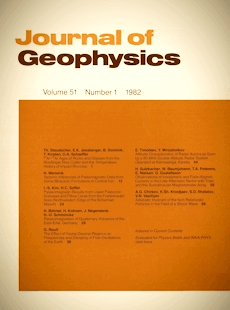Linearized solutions of kinematic problems of seismic body waves in inhomogeneous slightly anisotropic media
Article Sidebar

Vols. 1-18 (1924-1944), ISSN 0044-2801
Main Article Content
Abstract
The linearization approach to the evaluation of travel-times of seismic body waves propagating in inhomogeneous, slightly anisotropic media is discussed. General linearization equations are specified both for quasi-compressional and quasi-shear waves. Various situations of seismological interest are investigated in detail. This applies, e.g., to the situation where the unperturbed medium is isotropic and to the case where the unperturbed ray is a plane curve. The numerical examples presented suggest that the linearization approach gives travel-times of seismic body waves with an accuracy sufficient to solve direct and inverse kinematic problems for inhomogeneous anisotropic models of the Earth's crust and the uppermost mantle.
 ARK: https://n2t.net/ark:/88439/y051821
ARK: https://n2t.net/ark:/88439/y051821
Permalink: https://geophysicsjournal.com/article/175
Article Details
References
Alekseev, A.S., Lavrentev, M.M., Mukhometov, R.G., Nersesov, I.L., Romanov, V.G. (1970) Method for numerical investigation of horizontal inhomogeneities of the Earth's mantle from seismic data. In: Bune, V.I. (Ed.) Proc. of the 10th General Assembly of the ESC, Leningrad 1968, Vol. 1, pp. 26-36. Moscow: Acad. Sci. USSR (In Russian, English abs tr.)
Babich, V.M. (1961) Ray method for the computation of the intensity of wave fronts in the elastic inhomogeneous anisotropic medium. In: Petrashen, G.I. (Ed.) Problems in the dynamic theory of the propagation of seismic waves, Vol. 5, pp. 36-44. Leningrad: Leningrad Univ. Press (In Russian)
Backus, G.E. (1965) Possible form of seismic anisotropy of the uppermost mantle under oceans. J. Geophys. Res. 70:3429-3439
Červeny, V. (1972) Seismic rays and ray intensities in inhomogeneous anisotropic media. Geophys. J. R. Astron. Soc. 29:1-13
Červeny, V., Pšenčik, I. (1972) Rays and travel-time curves in inhomogeneous anisotropic media. J. Geophys. 38:565-577
Červeny, V., Molotkov, I.A., Pšenčik, I. (1977) Ray method in seismology. Praha: Univ. Karlova
Červeny, V. (1981) Direct and inverse kinematic problems for inhomogeneous anisotropic media. In: Hvozdara, M. (Ed.) Contributions of the Geophysical Inst. of the Slovak Acad. Sci., Vol. 13, Bratislava: Veda (In press)
Crampin, S. (1981) A review of wave motions in anisotropic andcracked media. Wave Motion 3:343-391
Gubbins, K. (1981) Source location in laterally varying media. In: Husebye, E.S., Mykkeltveit, S. (Eds.) Identification of Seismic Sources - Earthquake or Underground Explosion, pp. 543-573. Dordrecht: D. Reidel Publ. Co.
Firbas, P. (1981) Inversion of travel-time data for laterally heterogeneous velocity structure - linearization approach. Geophys. J. R. Astron. Soc. 67:189-198
Jech, J. (1982) Ray tracing system in an 2o transversely isotropic medium with a non-vertical axis of symmetry. Studia Geoph. Geod. (In press)
Novotny, M. (1981) Two methods for solving the linearized twodimensional inverse seismic kinematic problem. J. Geophys. 50:7-15
Romanov, V.G. (1972) Some inverse problems for hyperbolic equations. Nauka, Novosibirsk (In Russian)
Romanov, V.G. (1978) Inverse problems for differential equations. Novosibirsk Univ. Press (In Russian)











